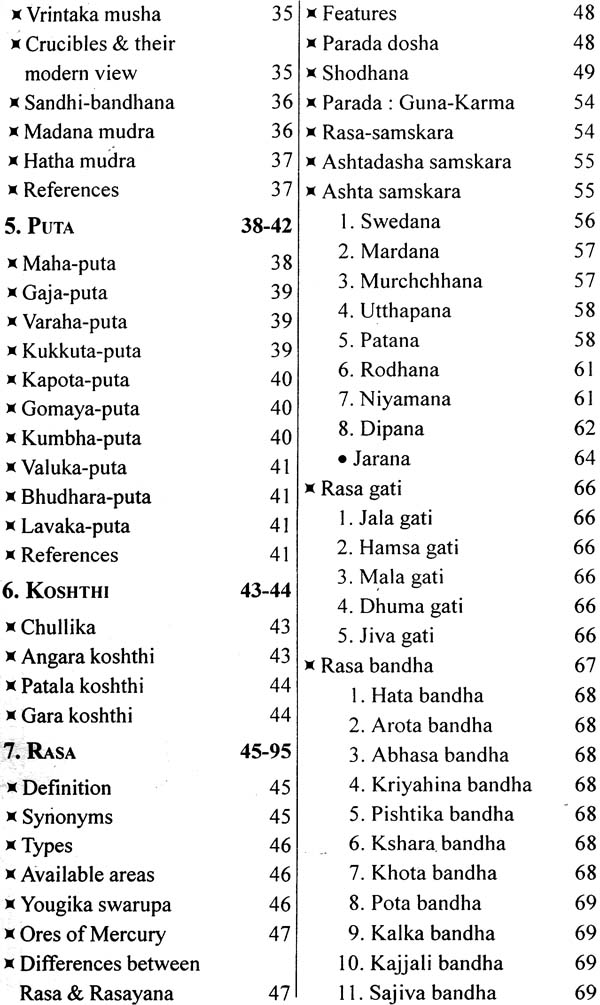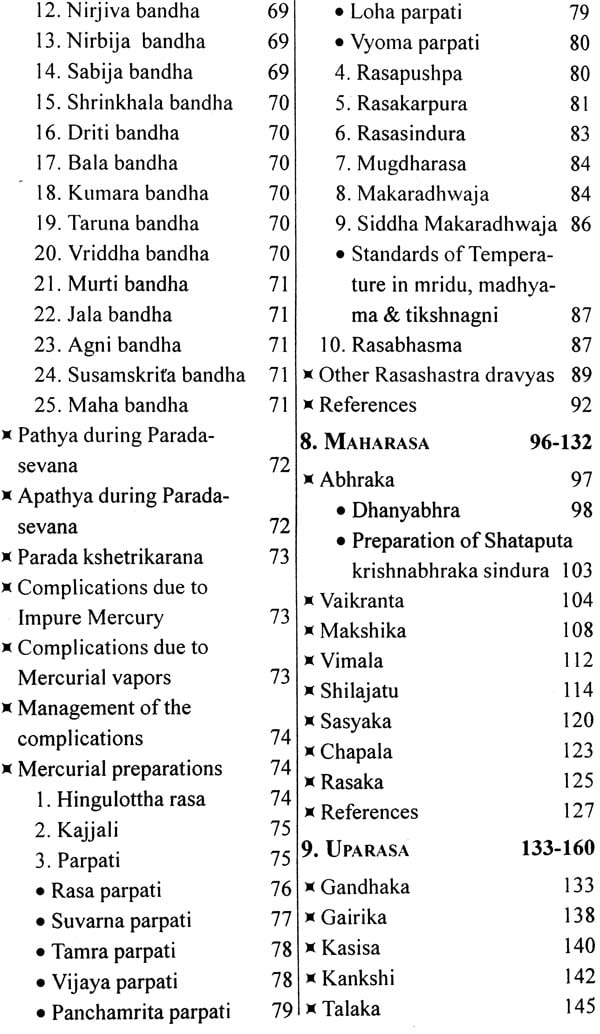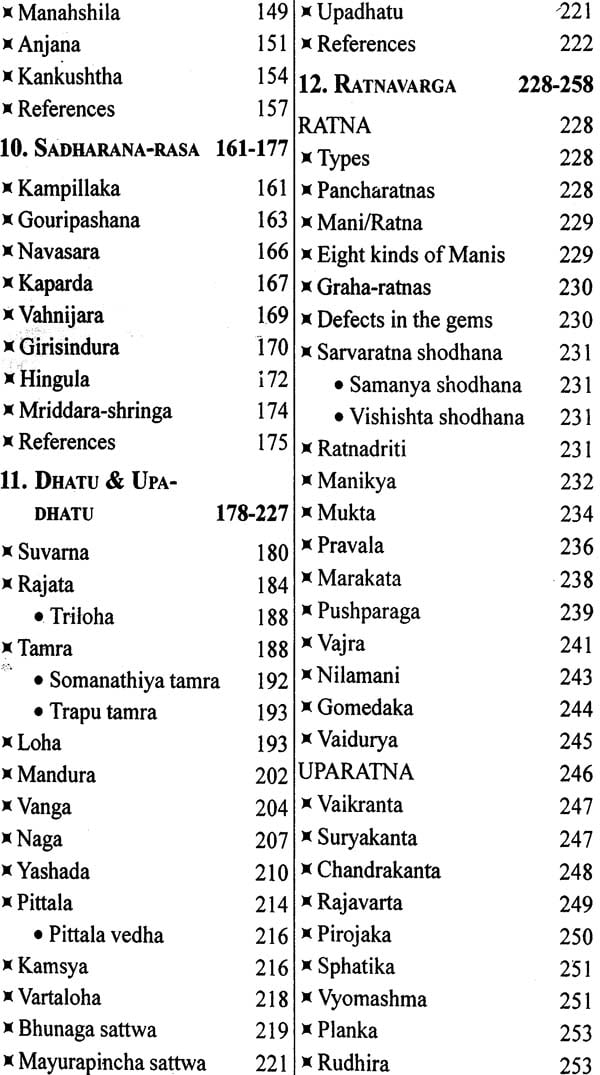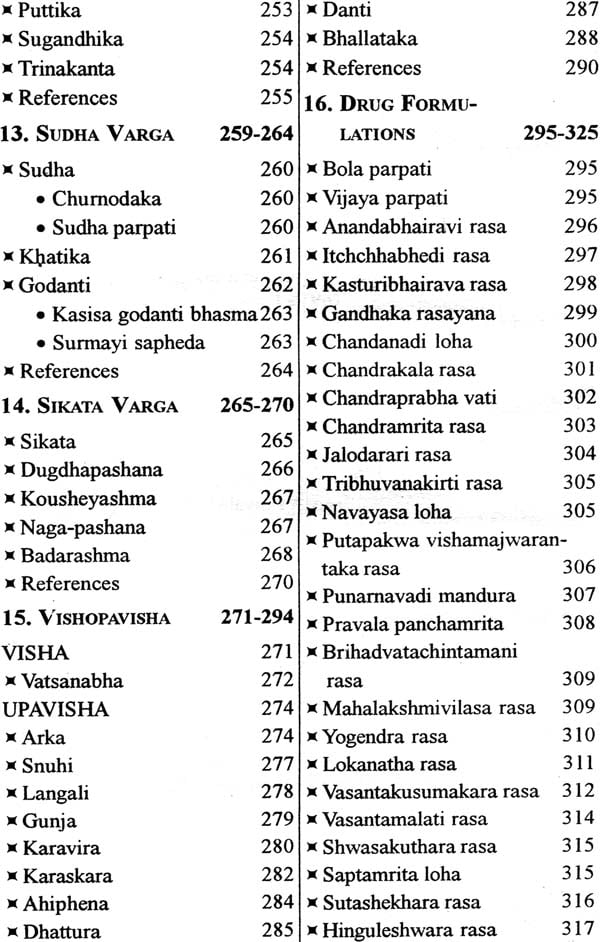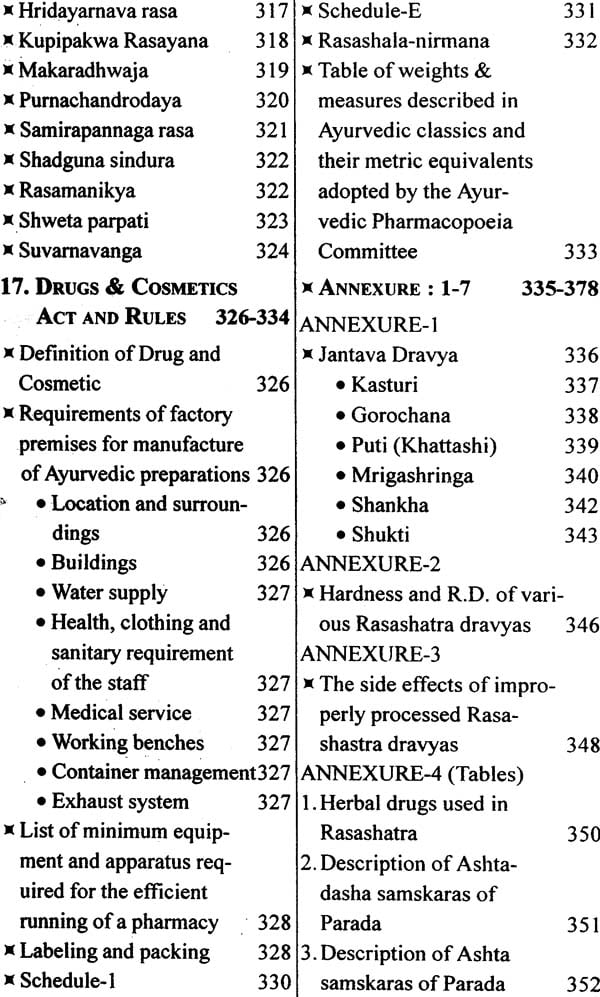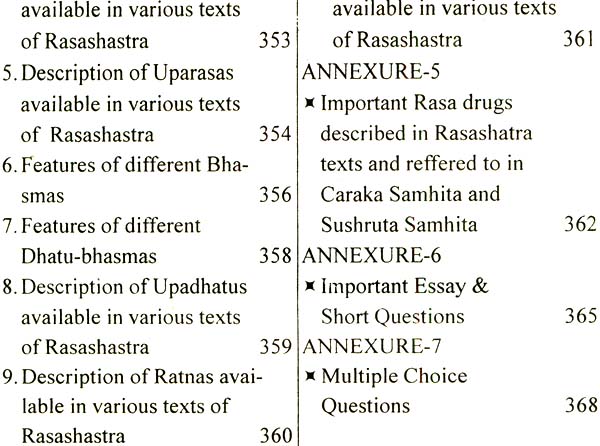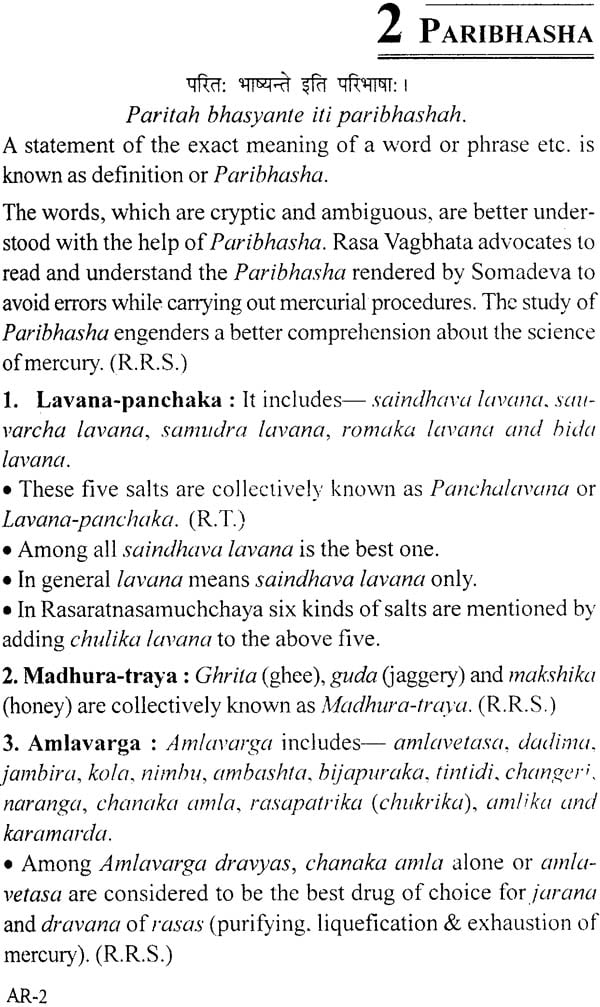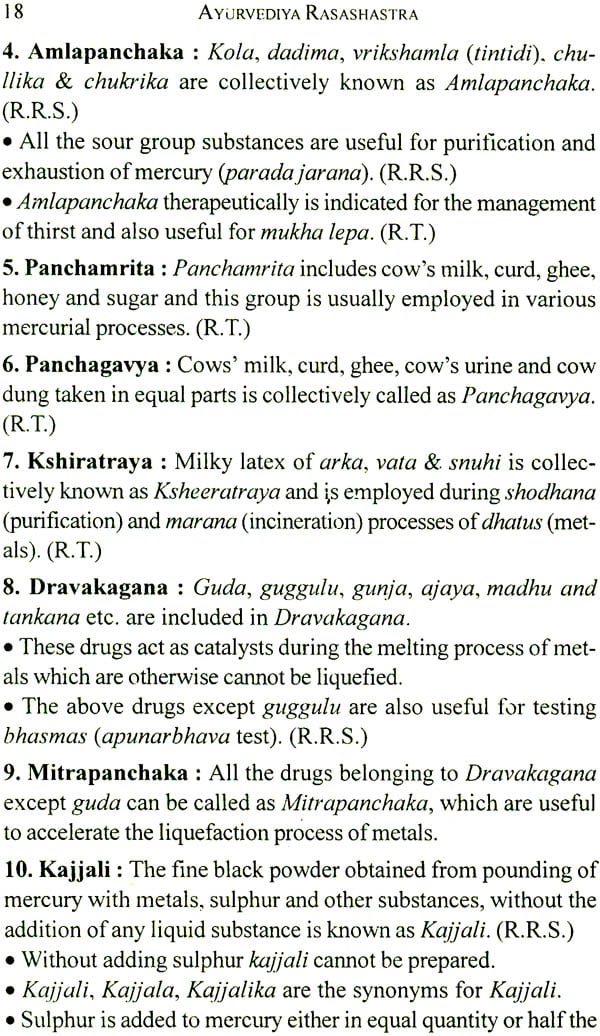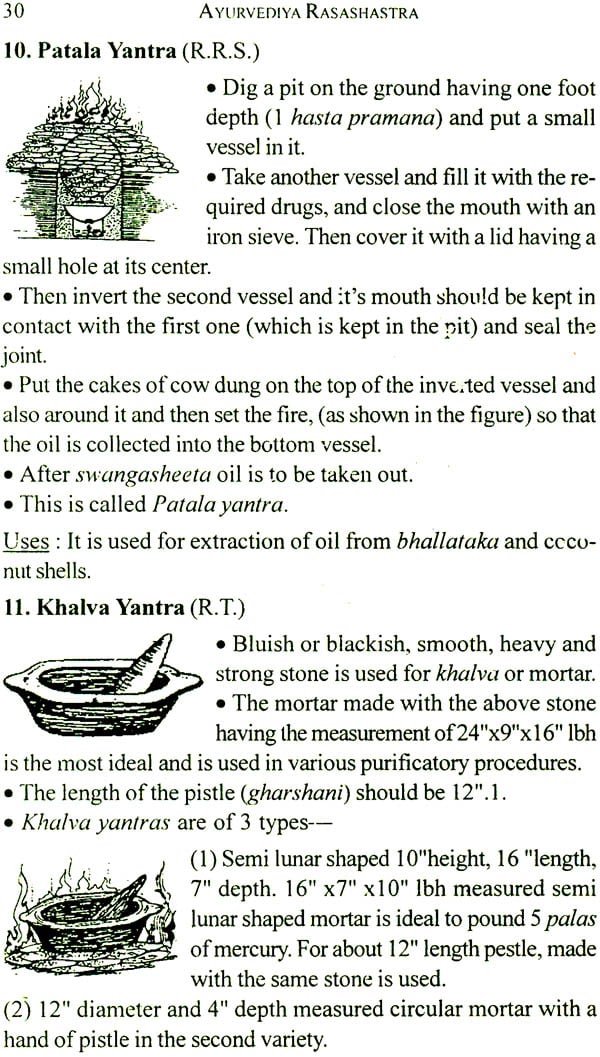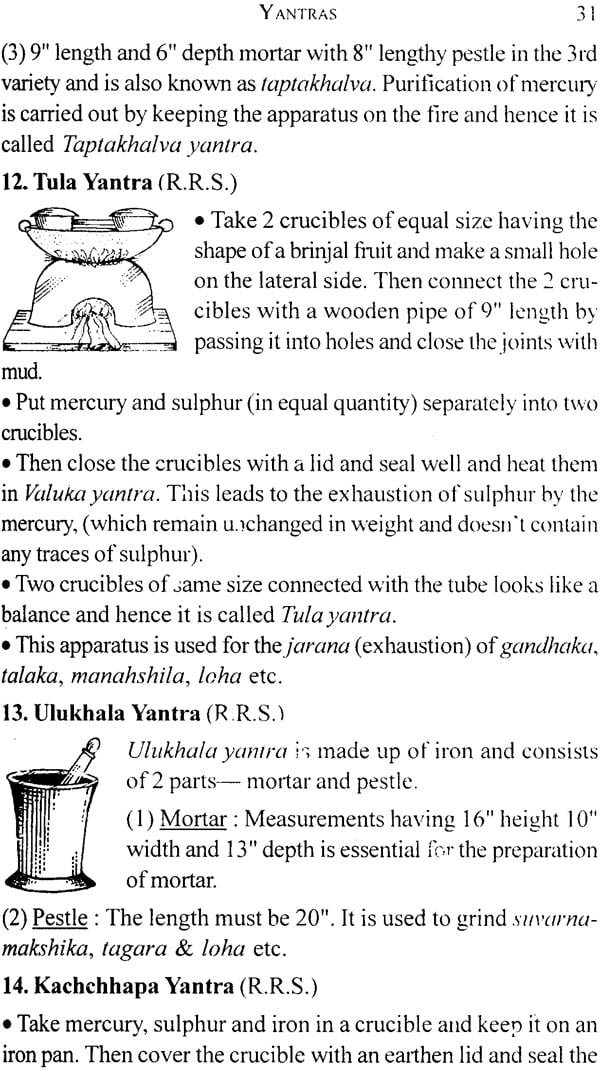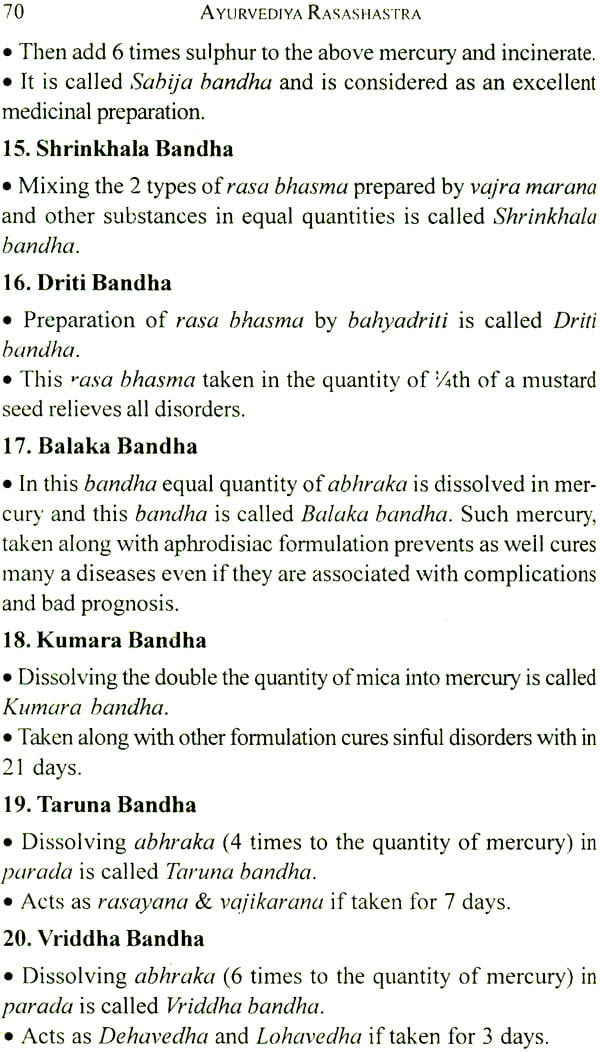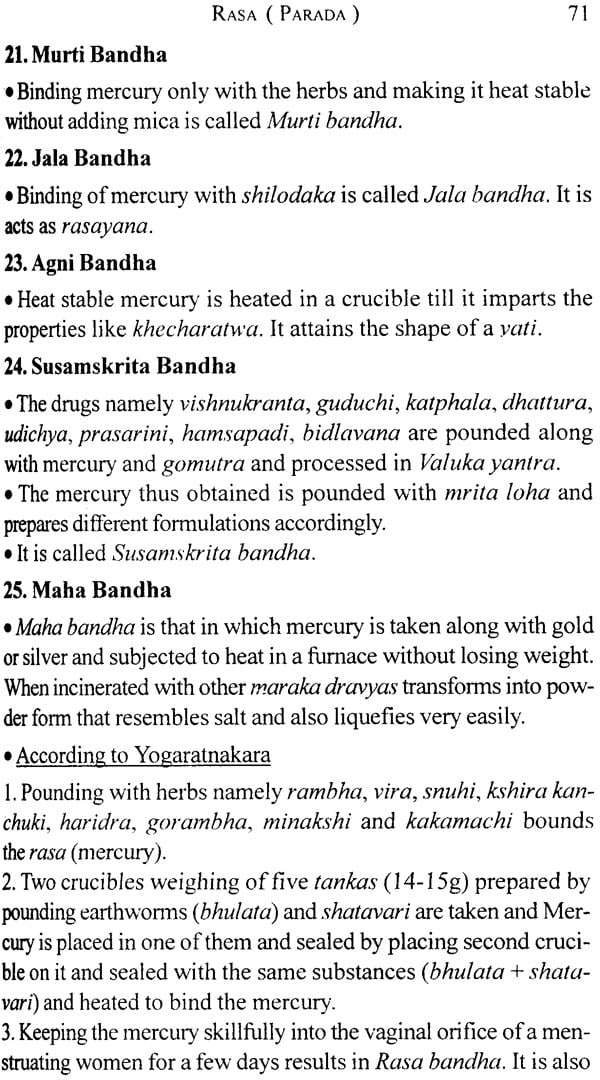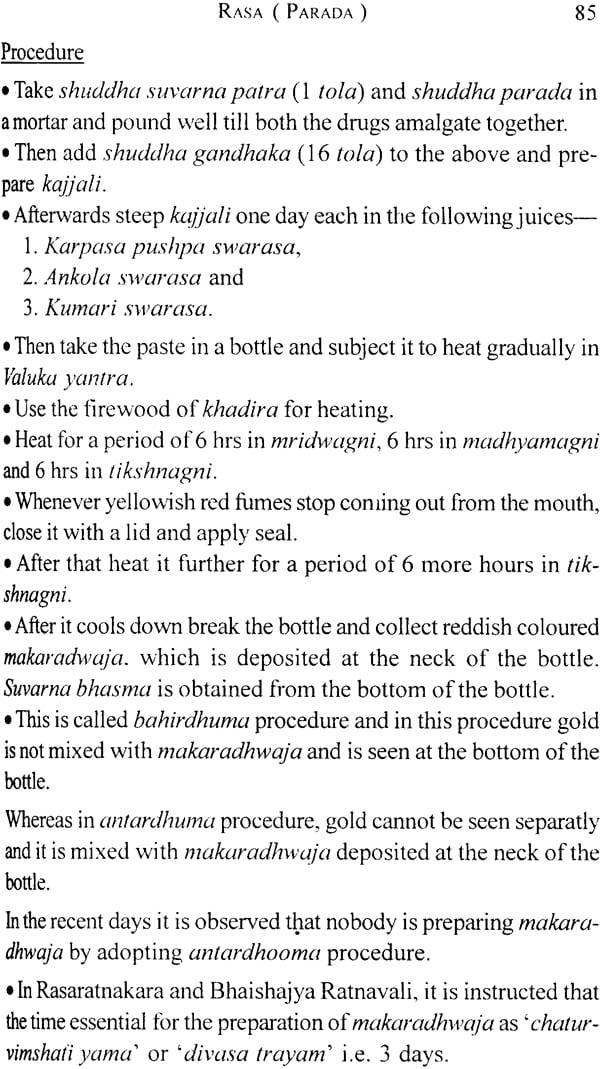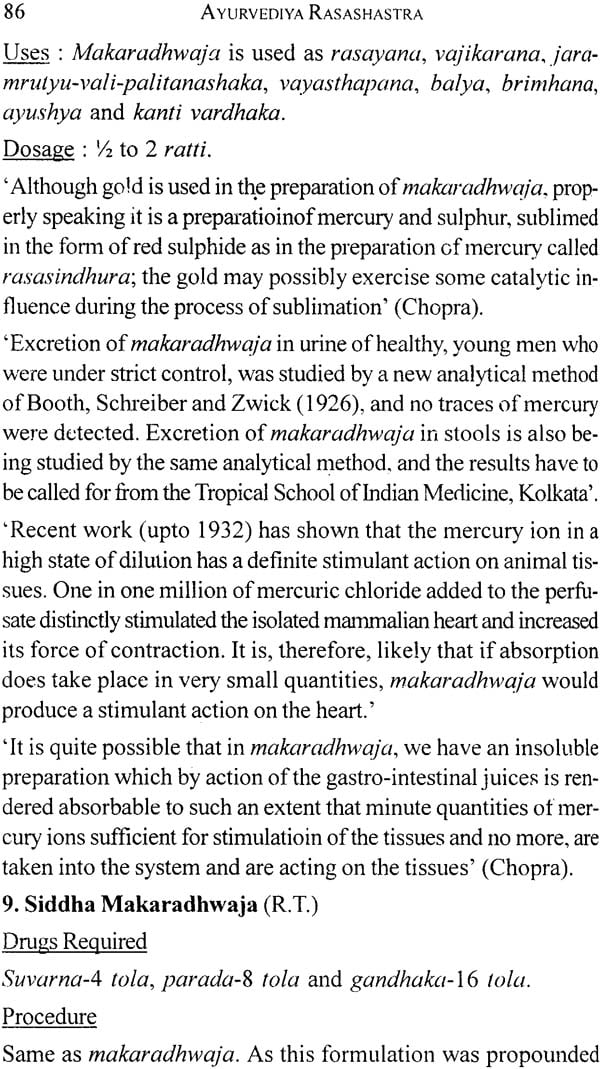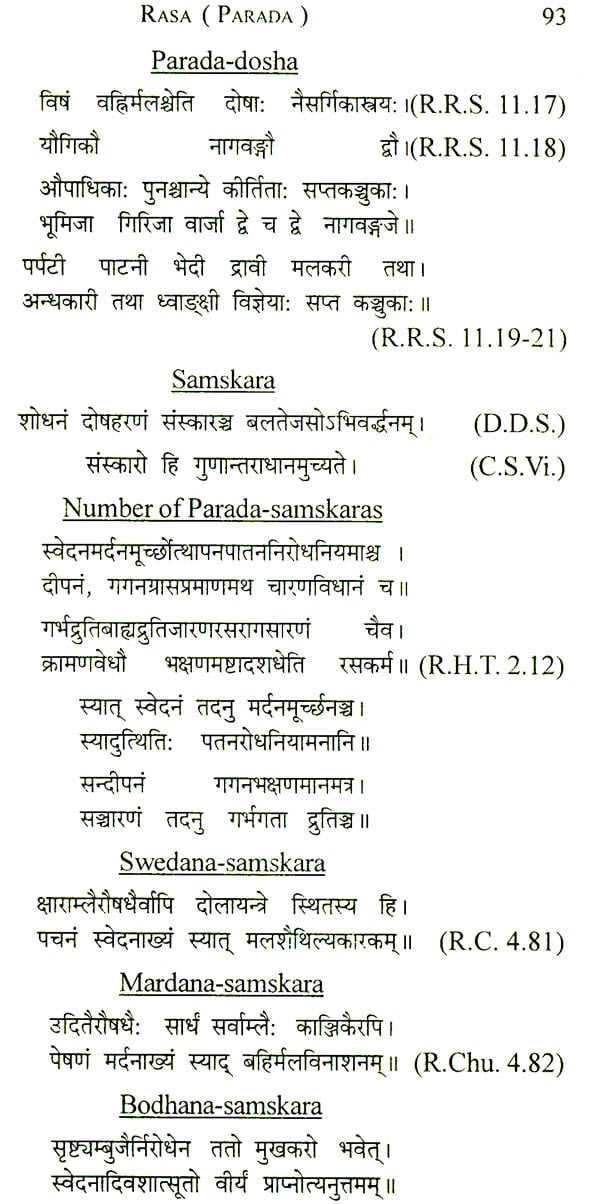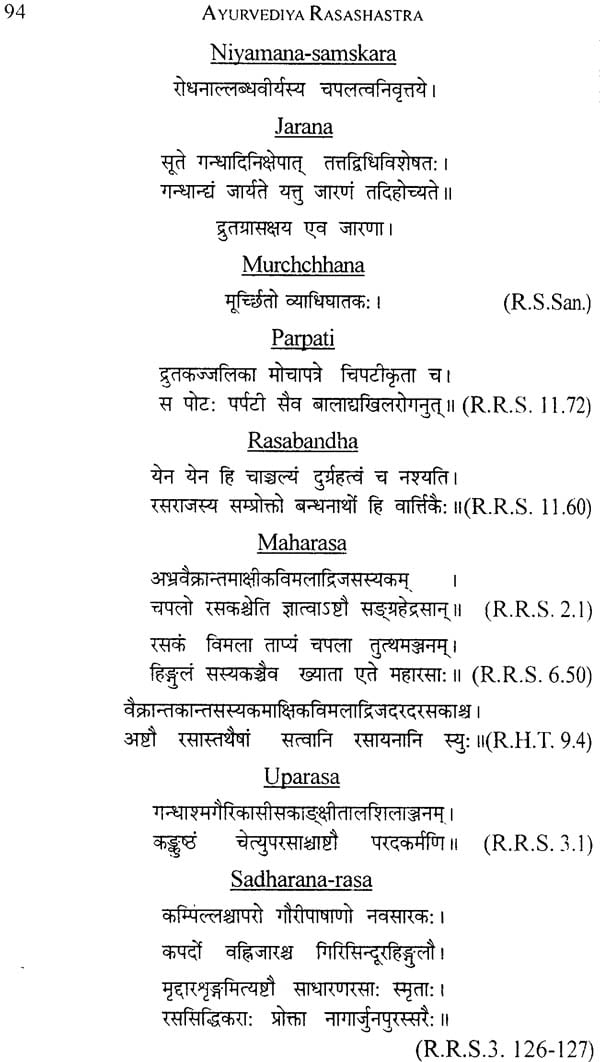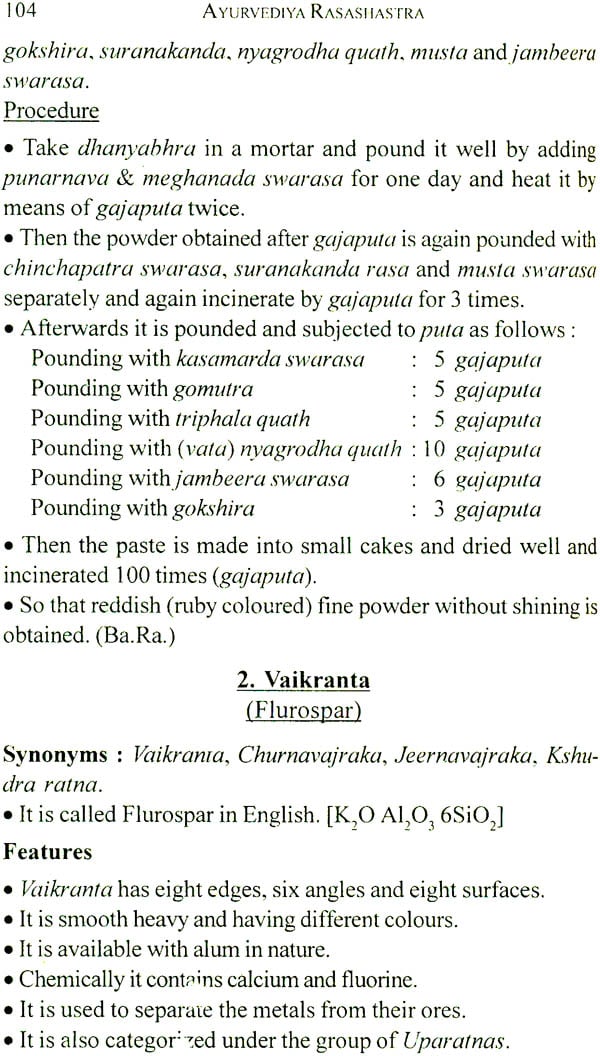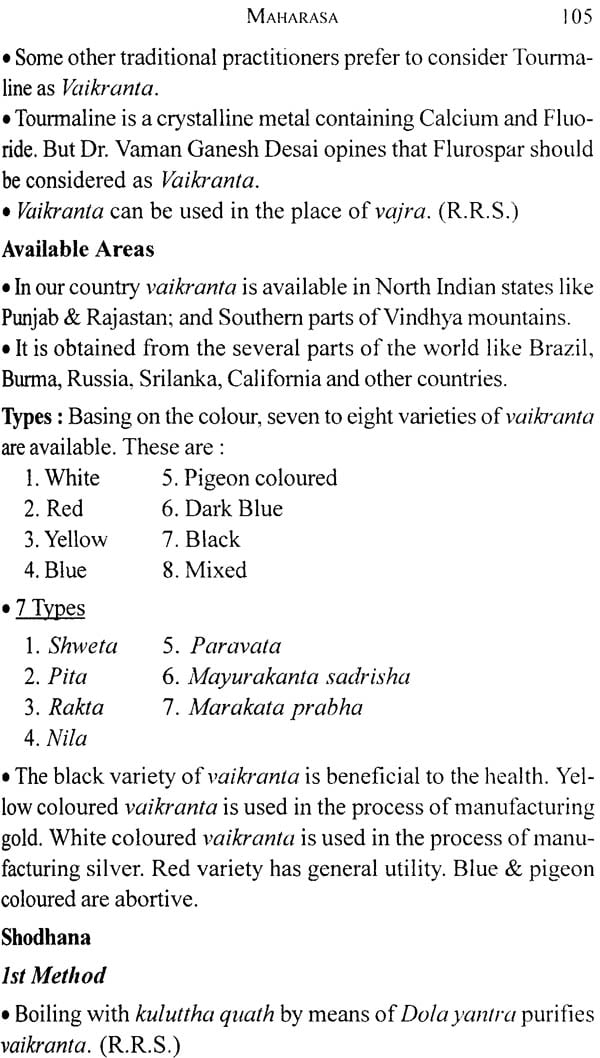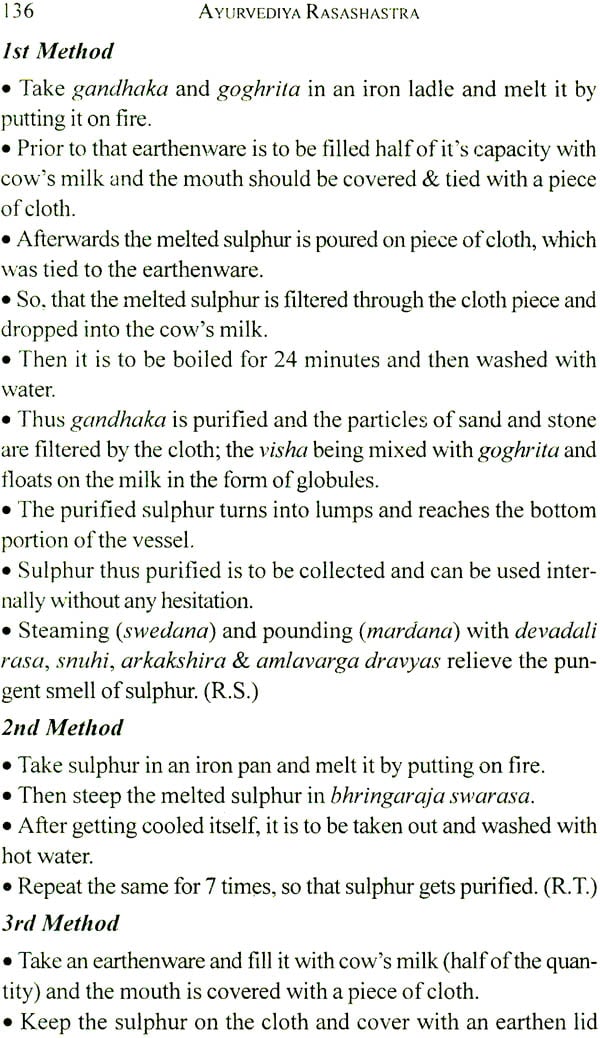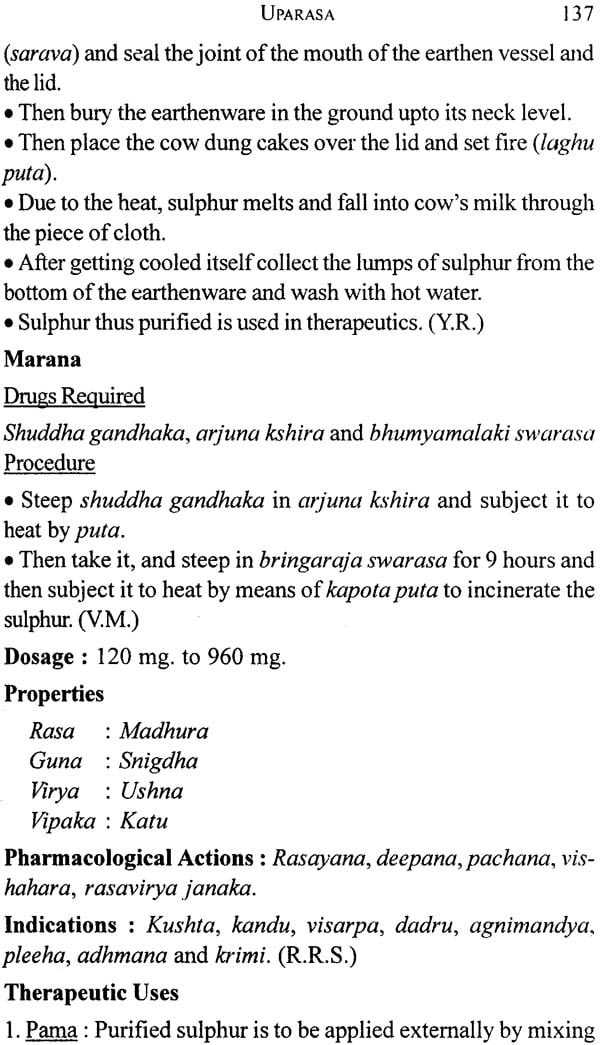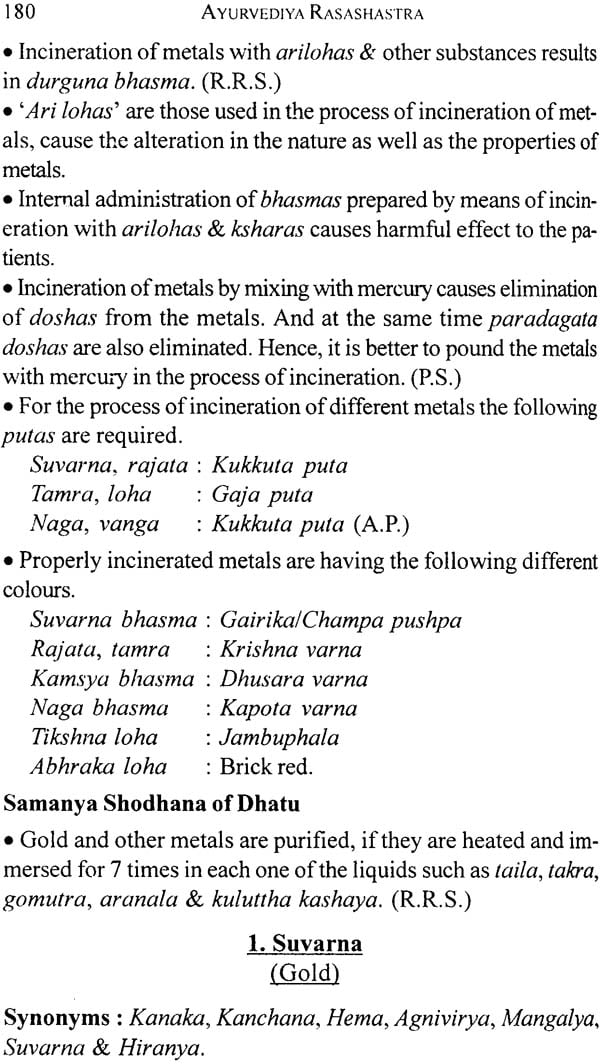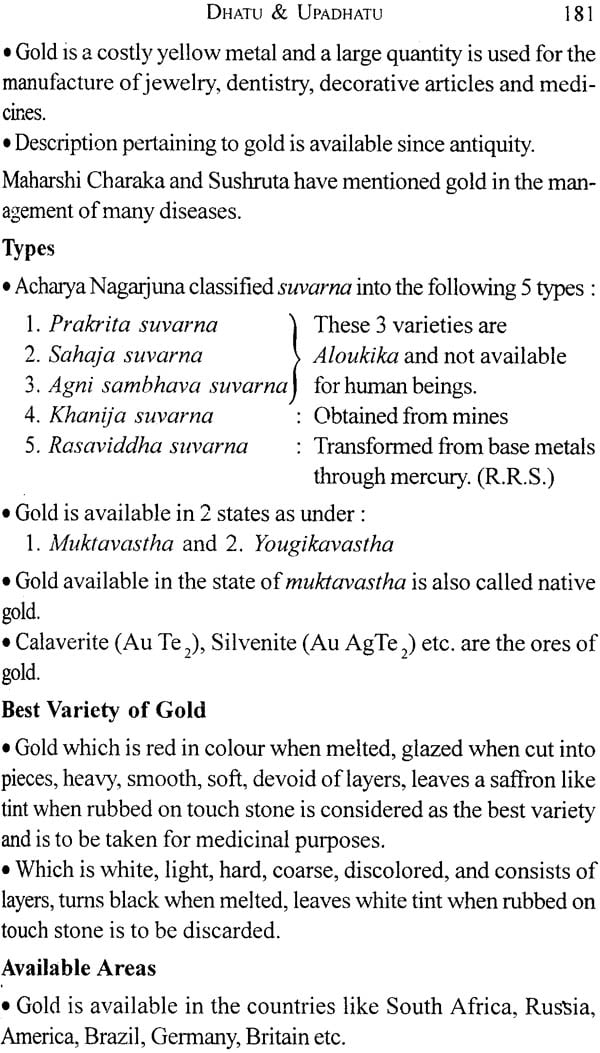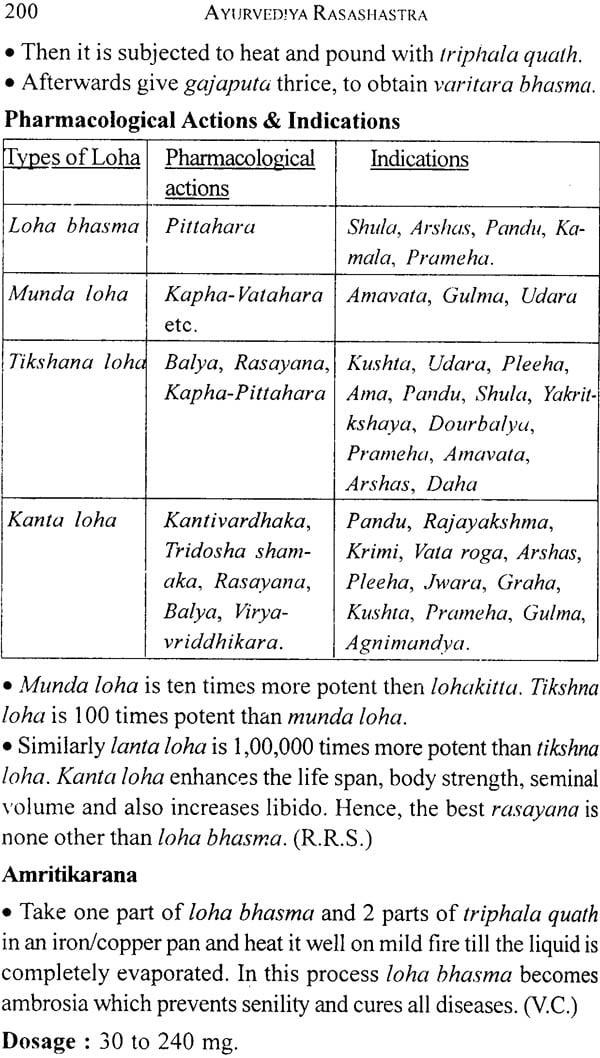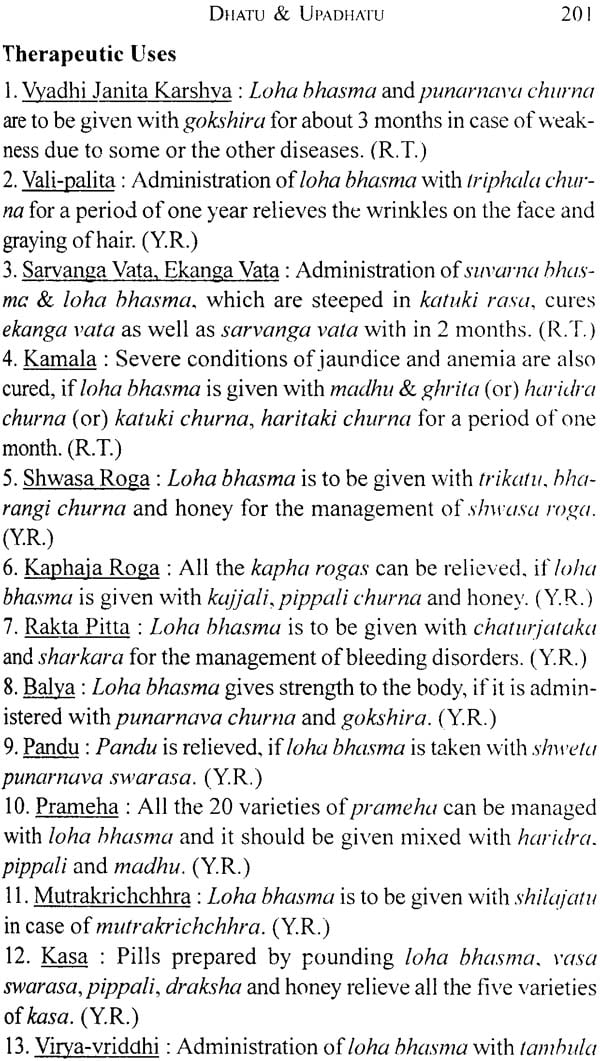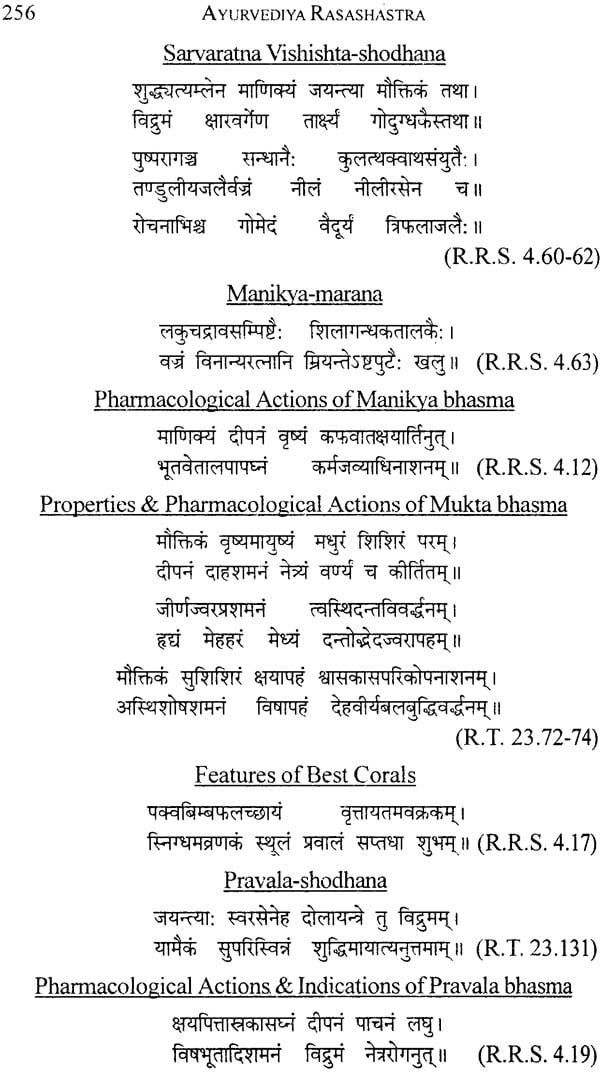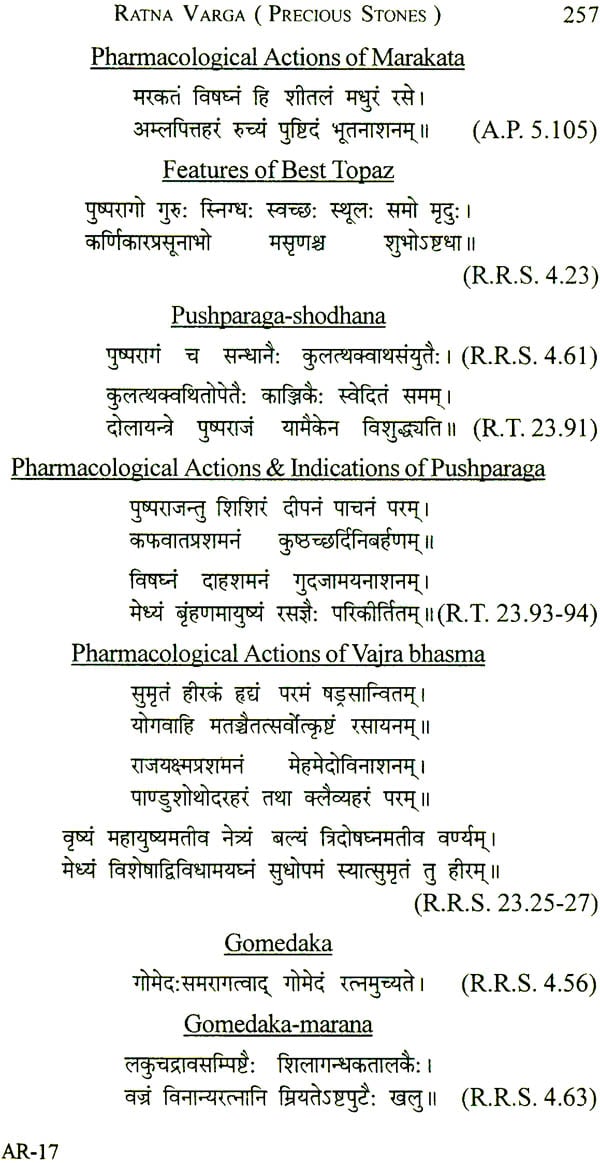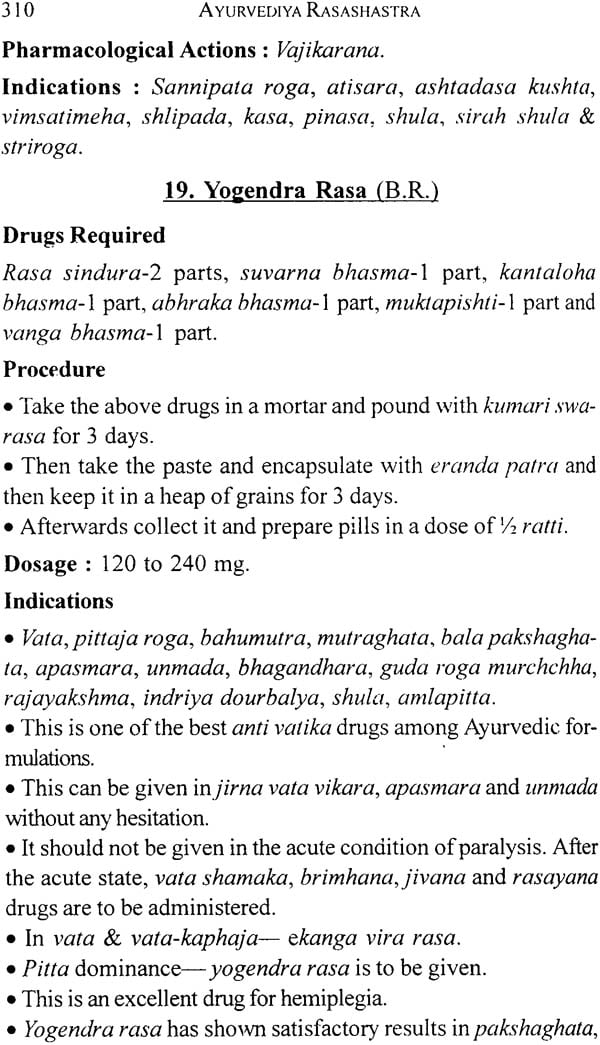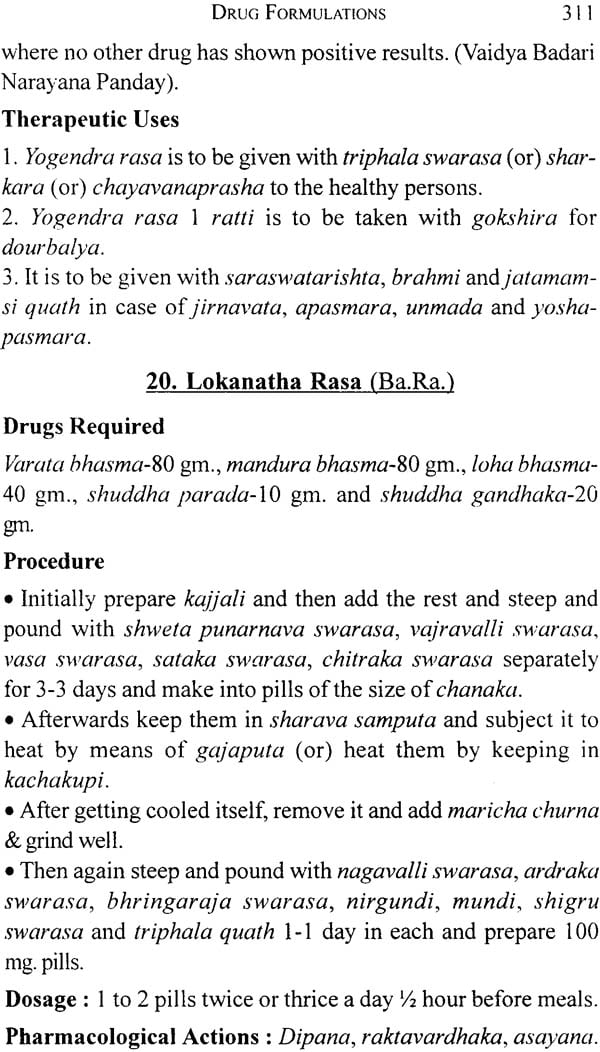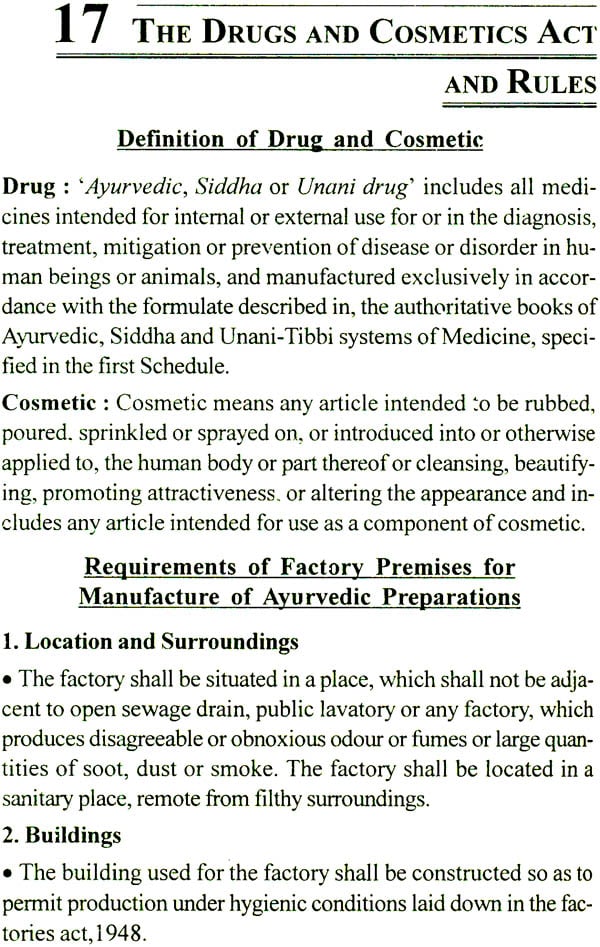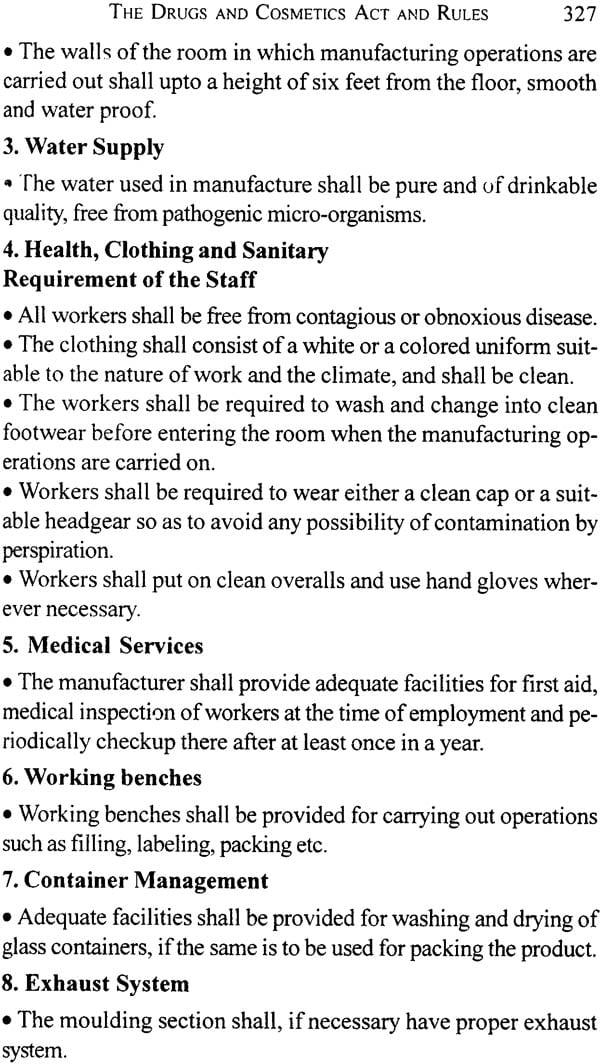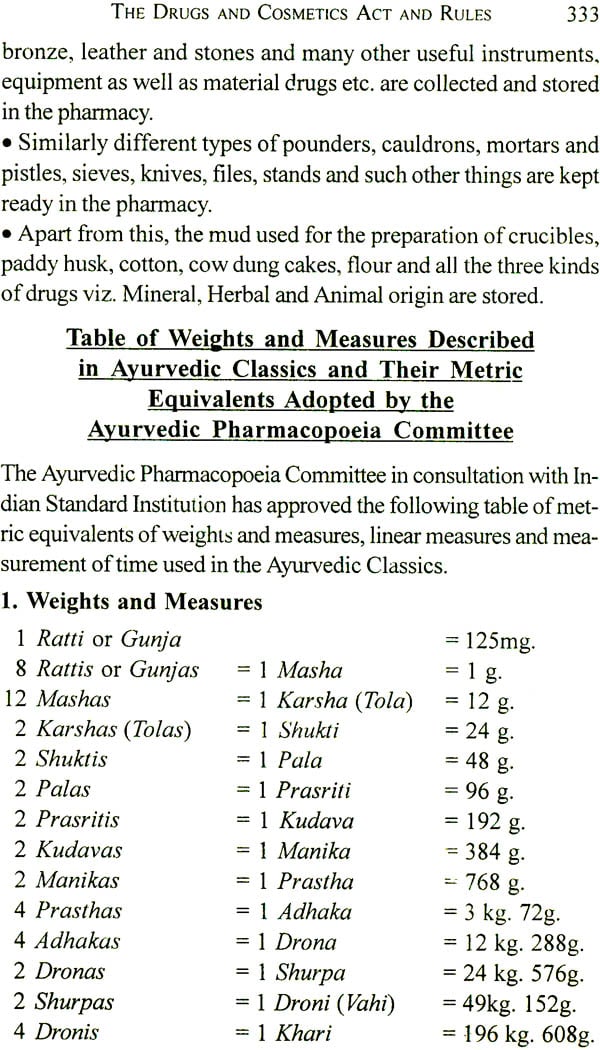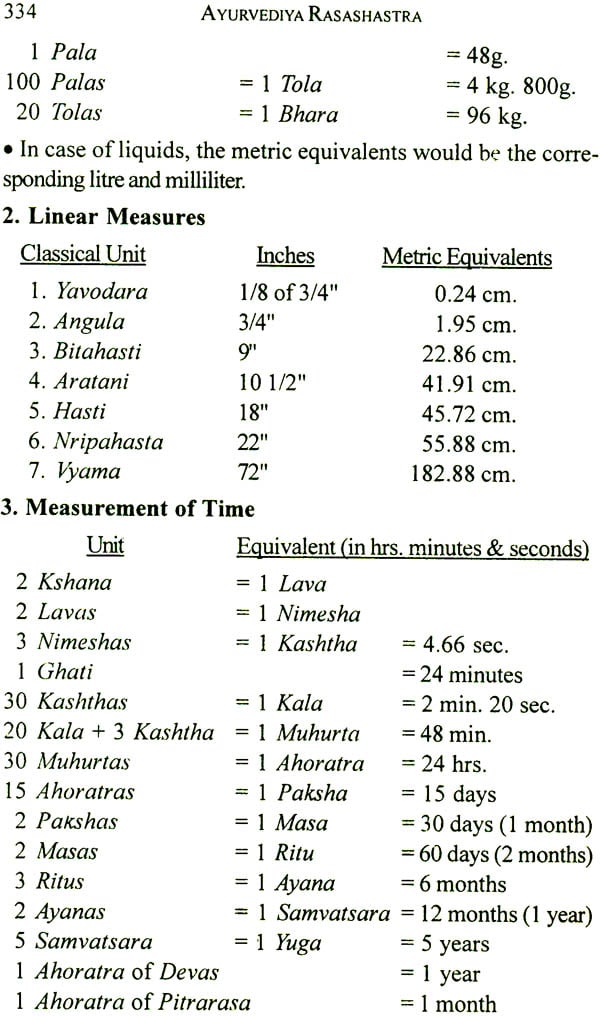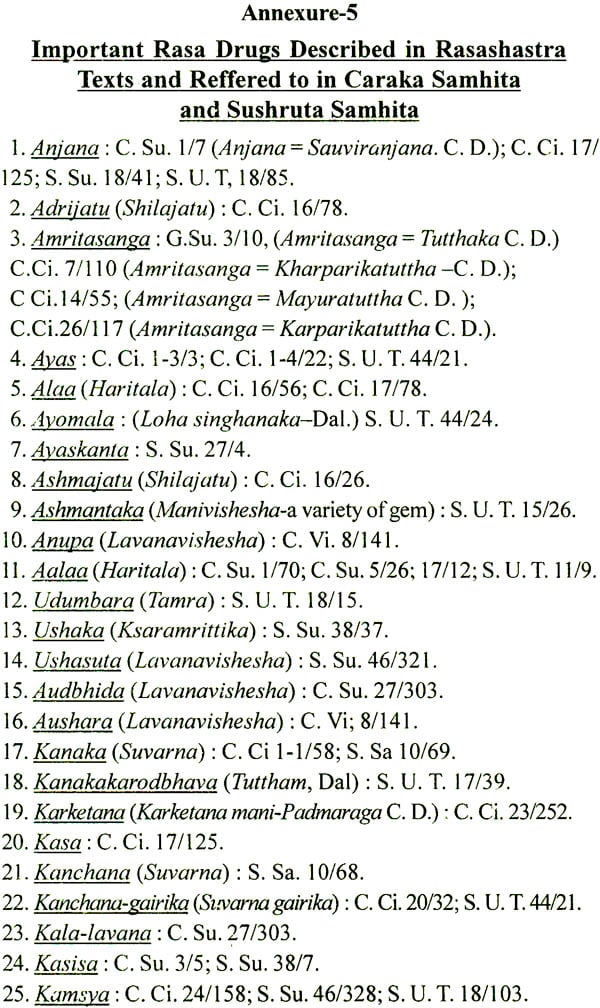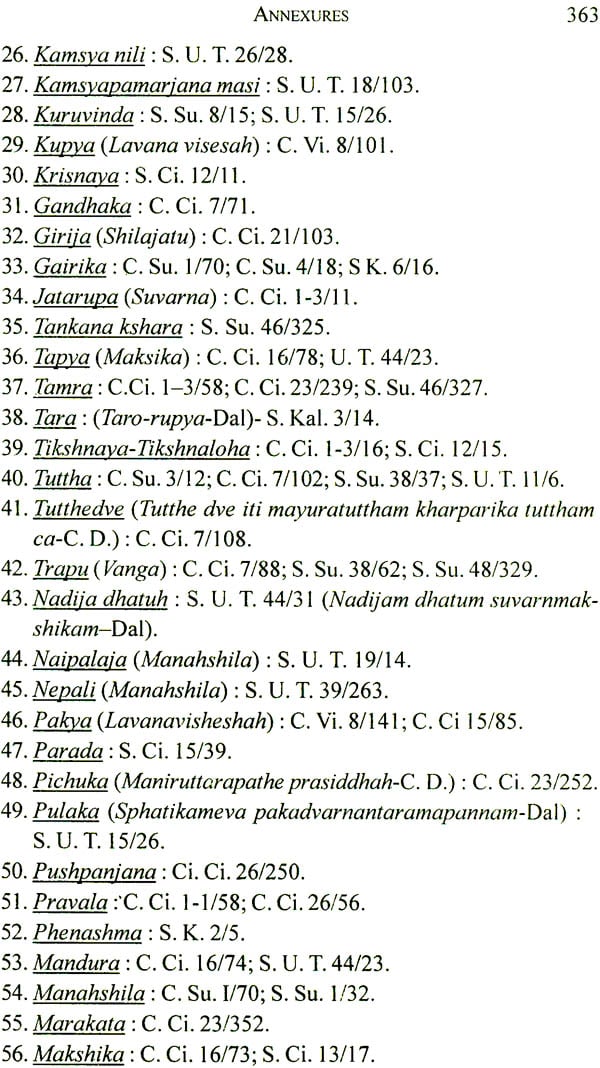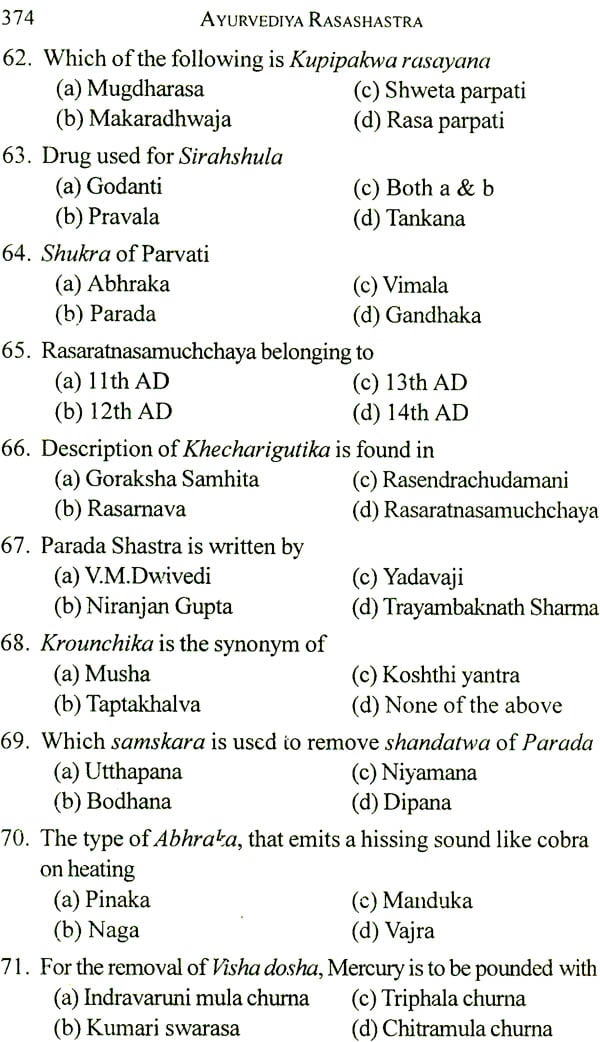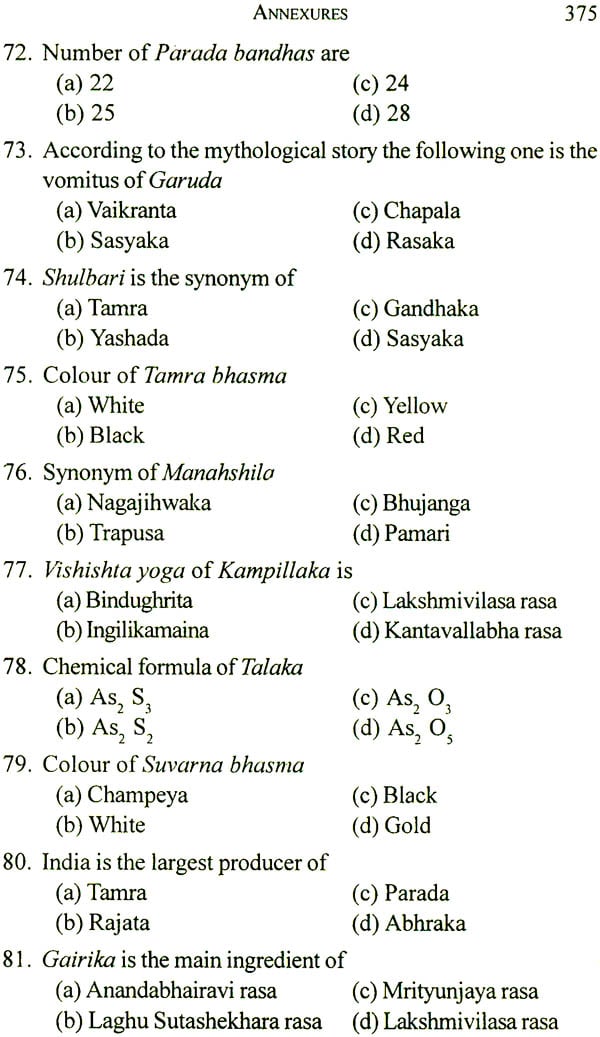
Ayurvediya Rasashastra
Book Specification
| Item Code: | NAJ277 |
| Author: | Dr. K. Nishteswar and Dr. R. Vidyanath |
| Publisher: | Chaukhamba Surbharati Prakashan |
| Edition: | 2010 |
| ISBN: | 9789383721092 |
| Pages: | 378 |
| Cover: | PAPERBACK |
| Other Details | 8.5 inch X 5.5 inch |
| Weight | 590 gm |
Book Description
Dr. k. Nishteswar, Currently Working as Asst. professor at Govt Ayurvedic College, Vijayawada has obtained his post-graduate degree from gujarat Ayurveda University and ph.D from university of pune. He also compleate d the diploma in AIDS from IGNOU. He served as a Clinical Registrar (Gujarat Aurveda University ), Research Assistant (CCRAS) and completed 23 years of service in fild of teaching and recived state Best Teacher Award from Govt. of Andhra pradesh during 2001. He was awarded several Gold and silver medals in recognition of his merit and theses on various topiccs like Diabetes, Hypertension, and cardio-vascular Disorders. He was conferred with D.Se., and D.Litt. by International University of complpmentary Medicines, Colombo for his contributions to the fild of Alternative medicines. He also delivered keynote lectures and Guest lectures in several National and International seminars. so far he has written more then 30 books in telugu, English and also in Hindi on verious subject of Aurveda and published approximately 80 papers in various standard journals.
Dr. R vidyanath, currently working as Lecturer at Govt Ayurvedic Collage. Vijayawada has obtained his M.D. (Ayurveda) from Gujarat Ayurveda University, Jamnagar. He had also undergone special training in panchakarma from International Institute of Ayurveda, Coimbatore and served as a clinical Registrar (Gujarat Ayurveda University, Jamnagar), Medical Officer at Government Ayuvedic Dispensaries and completed 10 years of service in the field of teaching. He presented more then 20 scientific papers at National and International Seminars and was the author of Panchakarma A Hand Book of History of Ayurveda and A Hand Book of Astanga Sangraha. He produced a videocassette on panchakarma for students and practitioners and also an audiocassette titled ' Ayurveda Hitopadesam' (Tenets of Life) to bring in awareness and popularize Ayurveda in the society.
Foreword
Ayurveda is a holistic life science. It covers all aspects of human life. The subject matter of Ayurveda is experience-based and practical. It gives guidelines for the wellbeing and positive health of the individual and entire society. It covers the broad aspects of life with theoritical and practical wisdom, following which a person can achieve physical & mental health and ultimately attains the spiritual goal of human life. Hence, it is considered a divine and holistic life science.
Positive diet regimen and life style provides healthy physico-mental status. Indulgence in an inappropriate manner with different sense objects, change of time and season cause a disease. Plants and animals are important sources of diet and drug. Diet provides nutrition and is essential for the maintenance of health. Drug is a tool that helps to eliminate diseases through its potency. Due to close proximity of man with nature, vegetables and animals are initially identified for both diet and drug. Later, minerals and metals were also identified and utilized initially for production of various house hold utensils, knives etc. and later for suturing needles and therapeutic purposes.
Earlier the learning of Ayurveda was divided into eight specialities and was known as Ashtanga Ayurveda. Nowadays, this whole Ayurvedic curriculum expanded up to eighteen subjects and each one has a separate entity. The idea is to impart thorough theory and practical knowledge of Ayurveda to the learners. Rasashastra & Bhaishajya-kalpana are also important branches of Ayurvedic Medicine. They deal with drug-identification, collection, preservation, storage, processing, product analysis (physico-chemical), toxicity, safety and efficacy evaluation, dose determination, clinical evaluation and then finally its clinical application.
Drug manufacturing part of Ayurveda is dealt in Rasashastra and Bhaishajya-kalpana. Earlier it was not a separate subject or independent branch of learning. It was a part of the study of Ayurveda and along with the clinical subjects, training in drug manufacturing was imparted to the learners. The subject matter of drug manufacturing is also scattered in Samhitas. Later, to provide better and detailed knowledge it is classified as a separate subject. Treatises like Sharngadhara Samhita were written in which separate chapters were compiled and allocated for the teaching and training of drug manufacturing. Later, many such types of texts were written and made available for this purpose.
The term Bhaishajya denotes Aushadha (drug material) where as Kalpana means Nirmana (preparation/manufacturing). In short, it is known as Pharmacy or Ayurvedic Pharmaceutics. Raw materials are abundantly available in nature. No substance in nature is available without some properties. Each material has certain therapeutic utility. To make it therapeutically suitable is the subject matter of Bhaishajya-kalpana.
In Samhita period use of mineral materials was limited. In due course of time (9-11century AD) with the development of processing techniques, mineral and metallic preparations became frequent in Ayurvedic therapeutics. This period is considered as a revolutionary period in the field of medicine. Small doses, lack of bitterness, quick effectiveness, long shelf life easy storage, easy transportation and effectiveness even in dreadful and chronic diseases made these mineral and metallic preparations popular and superior to the herbal medicine. This independently developed branch of mineral processing was recognized as Rasashastra. Earlier it was not limited only to therapeutics but was started with broad idea of Dehavedha and Lohavedha. The object of Dehavedha is to achieve success in therapeutics by the transformation of diseased and decayed body into a healthy and strong body with a long life span. Lohavedha provides alchemical achievements like transformation of lower metals into higher metals to attain prosperity and eradicate poverty. According to literature Lohavedha is a previous stage of Dehavedha (‘Aadau lauham parikshayeta tato dehe prayojyeta’). Dehavedha is also known as Dehasiddhi and it leads to ultimate object of Rasashastra, the salvation (Jeevan-mukti). It is also believed that the Dehasiddhi of Rasashastra is an expansion of Rasayana therapy of Ayurveda.
Mercury was considered as the chief material of Rasashastra. On the nucleus of Mercury this whole branch of Rasashastra was developed. Mercury is considered as the best Yogavahi. It consumes all the metals. Other minerals and metals were taken for its potentiation. The logical reasoning behind it is that Mercury is quick like mind and unstable like body. When Mercury is made stable, it provides stability in the body. Mercury is a heavy metal possessing various types of natural impurities. After subjecting it to specialized processes like Shodhana, Samskara, Jarana, Murchchhana, Bandhana etc. it becomes non-toxic and suitable for internal uses. On combination with other minerals and metals, it becomes potent and provides good Rasayana and medicinal effects. Mercury and its various combinations are considered potential and efficacious medicines. It is effective on deadly, chronic and even in incurable diseases. Due to the above said qualities Rasaushadhies became popular and recognized as the backbone of Ayurvedic therapeutics. Nowadays, the learning of Rasashastra is limited to drug manufacturing and therapeutics.
All three sources of material-Vegetable, Animal and Mineral-were identified for therapeutic purposes and used as raw materials in drug manufacturing. Minerals are associated with various impurities and toxins. Eradication of impurities and incineration of minerals to make them suitable for internal uses are tidious and time taking. The purification and incineration processes of minerals were developed during the medieval period and gained recognition as potential recipies after the 11th century AD.
Earlier physicians were preparing medicines of their own as per the need of their patients. Later drug manufacturing went into the hands of the pharmaceutical industries. There is a difference between the drug produced by the physician himself and by an industry. Production of a drug by himself makes the physician confident about the safety and efficacy of the drug. According to Ayurveda, treatment is based on individual, not in general (‘Purusham purusham veekshya’ ) and Prakrutitah and Vikrutitah. For the success of treatment, it is necessary for the physician to diagnose the disease properly. It includes the nature (Prakruti) of the patient, his constitution and construction (Sara & Samhanana), intensity of disease, age, habits (Satmya) etc. Accordingly physician selects and prepares the drugs for them. Hence, knowledge of drug manufacturing is necessary to a physician. Therefore, it is incorporated in the curriculum of Ayurveda.
Ayurveda is recognized for its doctrines and medicaments. In this present era, it is being globally accepted. It is due to genuine and standard medicines. Training in drug manufacturing is imparted to the Ayurvedic students during their period of study to make them confident about the drugs and successfully treat their patients with genuine and standard drugs. Earlier, the subject was taught through the ancient classical texts like Rasaratnasamuchchaya, Rasendrachudamani, Ayurvedaprakash etc. Now many compiled texts are written and available for the students according to the syllabus. Apart from Hindi, these books are also available in regional languages. Very few books are available in English on Rasashastra. Ayurveda when recognized globally there is a need of texts with good commentary in foreign languages. In this direction, this book will be considered a great contribution by the authors.
It is extremely a happy augury that Dr. K. Nishteswar along with Dr. R. Vidyanath has designed and created an important text on the subject of Ayurvediya Rasashastra.
I find the planning as very practical, information very authentic and description very precise to the point. I am confident that this will not only be useful to students, but also serve as an excellent book of ready reference to the research scholars and physicians. This text also conforms to the standards laid by Central Council of Indian Medicine (CCIM). The authors have taken care to incorpate latest references of standard research work on Rasashastriya drugs and furnished line diagrams for various apparatus like Yantra, Musha, Koshthi and Puta. I feel happy to recommend this book to all those serious students of Ayurveda who would like to update their knowledge in the subject of Rasashatra. I also wish to congratulate the authorities of Chaukhamba Surbharati Prakashan, Varanasi for taking up the publication responsibility to further the cause of Ayurveda.
Preface
Rasashastra is a science which deals with Mercury and other metals and minerals. The main concepts of Rasashastra are generally referred to Lohavedha/Rasavada/Dhatuvada (Alchemy) and Dehavedha or Rasayanavada. Sri Govinda Bhagavatpada in his book Rasahridayatantra mentions that Rasashastra is meant not only for Dhatuvada (Alchemy i.e. making gold/silver purpose) with a view to remove poverty from the world but also for Dehavedha which makes the body very strong, free from diseases, and stable for longer duration with the use of Mercury and Sulphur compounds. It is helpful for deep Sadhana (practice) which leads to Mukti (emancipation). In this particular context Dehavedha represents the Rasayana aspect of Parada. In a nutshell the concepts of Lohavedha and Dehavedha are considered to be prime objectives of Rasashastra.
Rasacharyas worked hard over a period of several centuries to achieve the objectives namely Lohavedha and Dehavedha, which is evident from the vast literature available on the subject of Rasashastra. Though Charaka and Sushruta described some of the metals and minerals along with their therapeutic utility in their works, it can be safely concluded that the actual development of Rasashastra as a specialised branch was started from the 8th century AD. The review of ancient literature of Rasashastra reveals that ancient Rasacharyas have observed toxic effects due to the impurities of metals and minerals and have evolved suitable remedial processes in the form of shodhana (purification) and marana (incineration) measures. During the classical age the drugs of mineral origin were used in the form of collyrium like fine powder (in the form of Anjanabha sukshma churna). Their marana method with the help of various Putas as mentioned in Rasa classics is not found in Charaka and Sushruta Samhitas. In Sushruta Uttara Tantra (18th chapter 85-95 verses) the method of preparation of churnanjana was described in which Sauviranjana, gold, copper and silver were diricted to be heated in a musha on fire and to be cooled by cow’s urine, curd, ghee and honey etc. for several times to turn them into fine powder form. Sushruta also described antardhuma Tuvaraka phala for administration to a madhumehi which can be considered as the first step in the development of concept of putapaka. In this way heat treatment for the process of medicine was found in the classical text. But the method of making bhasmas of mineral origin through angiputa became popular only after the development of Rasashastra.
The state of scientific and medical knowledge prevalent in India about the ninth or tenth century A.D. is known from the book on India written by the great Muslim scholar Alberuni who lived in India from 1017 to 1030 A.D. This versatile Muslim scholar left the following account as a true perspective of the chemical knowledge in India about the eleventh century A.D. ‘I only heard them (Hindus) speaking of the process of sublimation, or calcinations of alkalies and of the waxing of talc’ (sattwapatana). They have a science similar to alchemy which is quite peculiar to them. They call it Rasayana. It means an art which is restricted to certain operations, drugs and compounds and medicines most of which are taken from plants. Its principles restored the health to those who were ill beyond hope and gave back youth to fading old age.
The following statement of Alberuni bears out that a great Buddhist seer Nagarjuna, who is credited with the discovery of the process of distillation and calcination, must have lived in the eight or ninth century A.D.
‘A famous representative of the this art (Alchemy) was Nagarjuna, a native of the fort Daihek near Somanath, he excelled in it and composed a book which contains the substance of the whole literature on this subject and is very rare. He lived a hundred years before our time.
Hiuen Tsang, who stayed in India from 629 A.D. onwards makes the following remark regarding Nagarjuna; ‘Nagarjuna Bodhisattwa was well practised in the art of compounding medicine, by taking a preparation (Pill or cake) he extended longevity for many hundreds of years so that, neither the mind nor appearance decayed.’
It seems, therefore, that Nagarjuna, the father of Rasashastra lived in the seventh century A.D. or even earlier. There appears to be several Nagarjunas.
Indians’ knowledge about Metallurgy
Indians had knowledge of metals and their extraction from natural ores. Sir P.C. Roy, writes in his book ‘History of Hindu Chemistry’ regarding extraction of Zinc from the ore as follows - ‘Rasaka is mentioned in Rasamava as the mineral which turns Copper into Gold. The process is so elaborately given in Rasaratnasamuchchaya that it may be quoted almost verbatim in any treatise on Modem Chemistry. It is practically the same as the description per descensurn.’ It has now been recognised that ancient Indians were experts in preparing high class steel and the best example quoted in support of this statement is the Kutub Minar (Iron pillar 24 ft. height and 6 12 tons in weight) of Delhi which seldom rusts in spite of its exposure to atmosphere for centuries.
Ayurvedic Metallic Drugs are not Nephrotoxic: Makaradwaja is Nephroprotective
Ayurvedic physicians are prescribing metallic preparations without hesitation though Modem scientists apprehend that metals are potential nephrotoxic agents.
It is generally seen that Ayurvedic metallic drugs seldom cause renal damage. In a study it was observed that Makaradwaja prepared with Mercury, Gold and Sulphur protects the kidney from nephrotoxins. Shukla et al observed that Makaradwaja has no adverse effect on the kidney nor does enhance the toxicity due to Mercuric chloride administration. On the contrary, it protects the kidney against the toxic affects of Mercuric chloride.
Pandit Shiva Sharma quotes that the methods of dhatu-shodhana or the purification of metals described by Rasacharyas cannot be explained by any of the western process in Chemistry. Take, for example, the case of Makaradhwaja. It is a drug of undoubted celebrity not only in the sphere of Ayurvedic medicine, but also in the sphere of Western medicine. We come across advertisements of Merck’s Makaradhwaja (Germany), sold about thirty or forty times cheaper than the indigenous preparation sold by the Ayurvedic Physicians! The western preparation, when tried on patients fails to show its intended results.
Mahamahopadhyaya Gana Nath Sen describes the recognition made by the western doctors like Sir Charles Pardeay Luckis about Makaradwaja’s therapeutic efficacy and quotes it as one of the greatest triumphs of Ayurveda, which stands unparalleled amidst all the western specifics in its field of action. The ashes of Pearl, Conch, Cowry and Coral are all of the same colour and composition, all are oxides of Calcium, but for the Ayurvedist, they are entirely different from one another in their various medicinal properties, and he administers them to great advantage in many different maladies. The ashes of diamond and other precious stones are also included in this branch of Medical Chemistry.
About Bhasmikarana (Incineration)
The metal or mineral to be subjected to bhasmikarana (incineration) should first be processed with general or specific shodhana (Purification/detoxification) method.
Yadavji put more emphasis on sealing of joints when evaporating materials like Mercury, Sulphur etc. are added. But in the last 2, 3 putas he advised not to seal the samputa with a view to allow the fire and air to enter the samputa freely and to accelerate the chemical reactions desired to be set in smoothly and effectively as it may help in the conversion of metal or mineral into a desired compound and colour. Now-a-days electric furnaces are also being used for preparing almost all the bhasmas. But before using electric furnaces we should standardize the heating schedule and temperature range of different putas. And once that is done the heating through electric muffle furnace may be implemented to obtain better results and superior quality products. In this system controlled heat yields best results and heat may be conserved.
Controversies among Rasa Drugs
In Rasashastra one can come across certain controversies regarding the identification of Rasashastra drayvas namely-Chapala, Vimala, Vaikranta, Kankushta, Agnijara etc. Ayurvedic scholars like Acharya Yadavji, Dattatreya Anantha Kulakarni and Vaman Ganesh Desai tried to resolve the controversies to some extent. Various Post Graduate centers working on the subject of Rasashastra have made sporadic attempts in identifying drugs described in Rasashastra. A notable contribution has been made by Brihatrayi Ratna Dr. Namboori Hanumantha Rao (Andhra Pradesh), who developed an innovative technique to identify the presence or traces of any bhasma in a given formulation. This innovative test helps us to rule out the adulteration among Rasa yogas. A lot is to be studied for evolving standards of quality control of Ayurvedic formulations.
Rasashastra was introduced as a separate subject for the students of Ayurveda in various courses during 20th century and several books were published on this subject. Central Council for Indian Medicine (CCIM) has drafted the syllabus for this subject also and revised it once. The present book is written according to revised CCIM syllabus to serve the purpose of better comprehension about the subject. In the last chapter of this book different drug formulations given in the practical syllabus are mentioned and in the annexure, description of Jantava dravyas, hardness of different substances, side effects of improperly processed Rasashastra dravyas, Visha and their Shodhana procedures, important essay and short questions and MCQ’s are included.
This book serves as a text book for the students and it serves as a reference book to Ayurvedic physicians as well. We extend our sincere thanks to the Publishers, Chaukambha Surabharati Prakashan, Varanasi for arranging the publication of this book.

